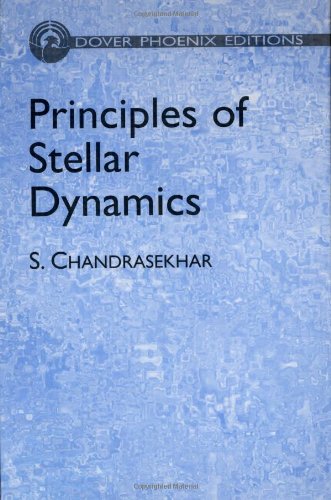Principles of Stellar Dynamics (Dover Books on Physics) - Hardcover

S. Chandrasekhar investigates two areas. The first concerns problems in which the time of relaxation of a stellar system is central. His method consists of analyzing the effects of stellar encounters in terms of the two-body problem of classical dynamics and applying this theory to the dynamics of star clusters. The second area investigates problems centering around Liouville's theorem and the solutions of the equation of continuity; here, the author discusses the dynamic implications of the existence of a field of differential motions, which appears to be the most striking kinematic feature of the galaxy and the extragalactic systems.
This edition includes two papers by the author that were published after Principles of Stellar Dynamics and that have been studied and quoted extensively: "New Methods in Stellar Dynamics" (originally published in the Annals of the New York Academy of Sciences) and "Dynamical Friction" (originally published in The Astrophysical Journal).
"synopsis" may belong to another edition of this title.
Subrahmanyan Chandrasekhar: A Shining Star
The great Indian astrophysicist Subrahmanyan Chandrasekhar (1910–1995), recipient of the Nobel Prize in Physics in 1983 for his work on the later evolutionary stages of massive stars, was not only the author of several books reprinted by Dover over many years, but a frequent and highly valued reviewer of titles in his field during the 1970s and 1980s. Chandrasekhar's books, published by Dover, are: An Introduction to the Theory of Stellar Structure, 1967; Hydrodynamic and Hydromagnetic Stability, 1981; Principles of Stellar Dynamics, 2005; Ellipsoidal Figures of Equilibrium, 1987; and Radiative Transfer, 1960.
For those concerned with the distant future ― the really distant future ― Chandrasekhar's name will always be associated with the Chandrasekhar Limit, the figure of 1.44 solar masses, the minimal mass above which a dying star will collapse into a black hole following a supernova. People on Earth need not be bothered anticipating such drama: for us, when the sun dies, the lights will just go out. In astrophysical terms, our sun will at that point be a stable white dwarf.
Critical Acclaim for Subrahmanyan Chandrasekhar:
"Any new fact or insight that I may have found has not seemed to me as a 'discovery' of mine, but rather something that had always been there and that I had chanced to pick up. I discovered true mathematical elegance from Subrahmanyan Chandrasekhar." ― Carl Sagan
"About this title" may belong to another edition of this title.
- PublisherDover Publications
- Publication date2005
- ISBN 10 048644273X
- ISBN 13 9780486442730
- BindingHardcover
- Number of pages336
(No Available Copies)
Search Books: Create a WantIf you know the book but cannot find it on AbeBooks, we can automatically search for it on your behalf as new inventory is added. If it is added to AbeBooks by one of our member booksellers, we will notify you!
Create a Want